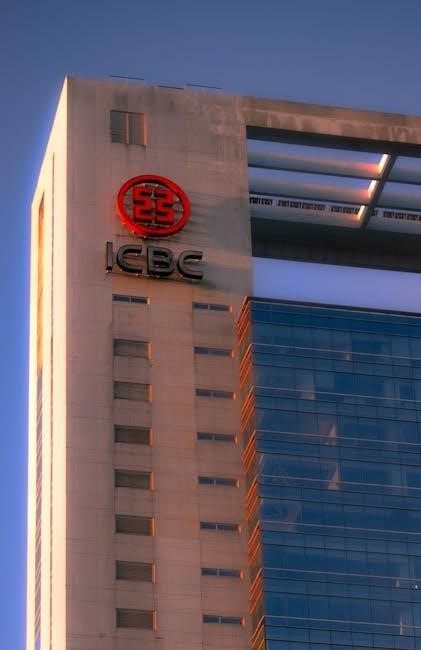The Financial Quadrant, introduced by Robert Kiyosaki, is a framework that categorizes income streams into four groups: Employee (E), Self-Employed (S), Business Owner (B), and Investor (I). It provides a roadmap to financial freedom, emphasizing the transition from active income to passive wealth-building strategies. This concept, detailed in Kiyosaki’s work, has become a cornerstone for understanding modern wealth creation and financial independence.

The Four Quadrants Explained
The Financial Quadrant, by Robert Kiyosaki, categorizes earners into four groups: Employees (E) trading time for money, Self-Employed (S) owning their jobs, Business Owners (B) building systems, and Investors (I) earning through assets, each offering unique paths to financial freedom.
2.1. Employee (E)
In the Financial Quadrant, the Employee (E) represents individuals who trade their time and skills for a paycheck. This is the most common quadrant, where people seek job security and stability. Employees rely on their employer for income, often exchanging hours worked for a fixed salary or wages. While this quadrant provides predictability, it limits financial growth due to the direct correlation between time and earnings. Employees typically lack control over their income potential and are dependent on their employer for financial stability. Kiyosaki emphasizes that while being an employee can provide comfort, it often restricts one’s ability to achieve true financial freedom, as income is tied to active work rather than passive assets. This quadrant is often the starting point for many, but it requires a mindset shift to move beyond it.
2.2. Self-Employed (S)
The Self-Employed (S) quadrant represents individuals who own their own businesses or work independently, such as freelancers, consultants, or small business owners. Unlike employees, they have more control over their work and earnings. However, their income is still directly tied to their personal efforts, meaning they often work long hours to generate income. While this quadrant offers more autonomy than being an employee, it shares a similar limitation: income depends on active involvement. Kiyosaki highlights that self-employed individuals are essentially “their own bosses” but are still trapped in the “time-for-money” cycle. This quadrant requires strong skills and dedication but lacks the scalability and passive income potential of the Business Owner (B) and Investor (I) quadrants. It is a step forward from being an employee but still falls short of true financial freedom.
2.3. Business Owner (B)
The Business Owner (B) quadrant represents individuals who own scalable businesses that can operate without their direct involvement. Unlike the Self-Employed (S), Business Owners create systems and teams that generate income independently of their personal effort. This quadrant is a key step toward financial freedom, as it allows for passive income and scalability. Kiyosaki emphasizes that true wealth is built by owning assets that produce income, rather than relying on a paycheck. Business Owners leverage systems, employees, and automation to grow their enterprises, freeing themselves from the “time-for-money” cycle. Moving into the B quadrant requires a shift from being a worker to becoming a leader and entrepreneur, focusing on building value that extends beyond personal labor. This mindset is central to achieving long-term financial independence and wealth.
2.4. Investor (I)
The Investor (I) quadrant represents the pinnacle of financial freedom, where individuals generate income through investments rather than active work. Investors earn money passively through assets such as stocks, real estate, bonds, and businesses. This quadrant requires financial knowledge, risk tolerance, and the ability to manage investments effectively. Kiyosaki highlights that investors build wealth by leveraging other people’s money and resources, creating a steady cash flow without direct involvement. The key to success in this quadrant is understanding market trends, diversifying investments, and maintaining a long-term perspective. Investors often achieve financial independence, enabling them to live off their investment income without needing a traditional job. This quadrant embodies the ultimate goal of the financial journey described in Kiyosaki’s teachings, where wealth is built and sustained through smart investment strategies.

Benefits of the Financial Quadrant Concept
The Financial Quadrant concept, popularized by Robert Kiyosaki, offers numerous benefits for individuals seeking financial freedom. It provides a clear framework for understanding how income is generated and how wealth can be built. By categorizing income streams into four quadrants (E, S, B, I), individuals can identify their current position and create a roadmap for transitioning to more passive and scalable income sources. This concept emphasizes the importance of financial education, encouraging people to think beyond traditional employment and explore entrepreneurship and investing. It also highlights the distinction between active income (earned through labor) and passive income (earned through assets). The quadrant system helps individuals clarify their financial goals, reduce reliance on a paycheck, and build a sustainable path to financial independence. Ultimately, it empowers individuals to make informed decisions about their money and lifestyle, aligning with Kiyosaki’s philosophy of wealth creation and financial freedom.

How to Apply the Quadrant in Personal Finance
Applying the Financial Quadrant concept to personal finance involves assessing your current position and strategically transitioning to higher-income streams. Start by identifying which quadrant you currently belong to (E, S, B, or I) and set clear financial goals. For those in the E or S quadrants, focus on building skills and assets that can move you to the B or I quadrants. Invest in financial education to understand how to create passive income through businesses or investments. Diversify income sources by acquiring assets that generate cash flow, such as real estate, stocks, or businesses. Minimize liabilities and maximize investments that align with your long-term financial objectives. Regularly review and adjust your financial strategy to ensure progress toward financial independence. By leveraging the quadrant framework, individuals can create a personalized roadmap to achieve financial freedom and wealth. This approach emphasizes actionable steps over theoretical concepts, making it practical for everyday application.

Analysis of the Quadrant’s Impact on Financial Freedom
Robert Kiyosaki’s Financial Quadrant framework provides a clear roadmap for achieving financial freedom by understanding income sources. The quadrant highlights the difference between active income (E and S) and passive income (B and I). Those in the B and I quadrants often achieve financial freedom faster, as their income is less dependent on personal effort. By transitioning from the left (E/S) to the right (B/I) side, individuals can reduce reliance on a paycheck and build wealth through businesses and investments. The quadrant emphasizes the importance of asset ownership and passive income streams, which are critical for long-term financial independence. This concept has empowered millions to rethink their financial strategies, focusing on wealth-building rather than salary dependence. The quadrant’s simplicity makes it a powerful tool for anyone seeking to escape the cycle of traditional employment and achieve true financial freedom. Its impact lies in its ability to transform mindsets and financial behaviors;
Criticisms and Controversies Surrounding the Concept
Robert Kiyosaki’s Financial Quadrant has faced criticism for oversimplifying complex financial strategies. Some argue that the concept discourages stable employment without providing practical steps for transitioning to entrepreneurship or investments. Critics also note that the quadrant may not account for varying economic conditions or individual circumstances. Additionally, Kiyosaki’s emphasis on debt as a financial tool has been controversial, with some experts warning against its risks. The lack of concrete evidence supporting the quadrant’s universal applicability has also been questioned. Despite its popularity, the framework remains a subject of debate among financial experts, with some praising its motivational impact while others caution against its potential for misguiding unsophisticated investors. Overall, the Financial Quadrant is viewed as a useful but imperfect guide that requires careful consideration of individual financial goals and risks. Its effectiveness largely depends on how it is applied in real-world scenarios. The concept continues to spark discussions about its merits and limitations in the pursuit of financial freedom.

Real-Life Success Stories of Moving from E/S to B/I Quadrants
Many individuals have successfully transitioned from the E/S (Employee, Self-Employed) quadrants to the B/I (Business Owner, Investor) quadrants, achieving financial freedom. One notable example is Robert Kiyosaki himself, who moved from being a struggling employee to building businesses and investing in real estate. His journey exemplifies the principles outlined in his books. Another inspiring story is that of entrepreneurs who started small businesses and scaled them into profitable ventures, eventually transitioning to passive income through investments. These success stories highlight the power of shifting from active income to passive wealth-building strategies. They demonstrate how applying the Financial Quadrant concept can lead to significant financial growth and independence. Such real-life examples motivate others to pursue similar paths, emphasizing the importance of financial education and mindset shifts in achieving long-term prosperity.
Steps to Transition from the Left Side (E/S) to the Right Side (B/I) of the Quadrant
Transitioning from the E/S (Employee, Self-Employed) to the B/I (Business Owner, Investor) quadrants requires strategic steps. First, build financial literacy by understanding investing, taxes, and business systems. Second, start or acquire a scalable business that generates passive income, reducing reliance on personal effort. Third, invest in income-generating assets, such as real estate or stocks, to build wealth. Fourth, minimize debt and optimize financial leverage to enhance growth. Finally, network with like-minded individuals who can offer guidance and opportunities. By following these steps, individuals can move from actively earning income to passively generating wealth, achieving financial freedom as described in Kiyosaki’s teachings. Consistency and patience are key to successfully navigating this transition and securing long-term prosperity.

The Role of Financial Education in Quadrant Success
Financial education is the cornerstone of achieving success within the Financial Quadrant framework. Robert Kiyosaki emphasizes that traditional schooling often fails to teach practical money skills, making self-education crucial for financial freedom. Understanding concepts like cash flow, investing, and tax strategies empowers individuals to make informed decisions. Financial literacy bridges the gap between the E/S and B/I quadrants by fostering a mindset shift from earning income to building wealth. It encourages people to think critically about passive income streams and long-term financial security. Continuous learning and applying financial knowledge are essential for navigating the quadrants effectively. By prioritizing financial education, individuals can overcome limitations and unlock opportunities for prosperity. This foundation is vital for transitioning from active income to passive wealth generation, ultimately achieving financial independence.
Comparison of the Financial Quadrant with Other Financial Models
The Financial Quadrant differs from other financial models by focusing on income streams rather than traditional budgeting or investing strategies. Unlike the 50/30/20 rule, which allocates income into needs, wants, and savings, the Quadrant emphasizes active versus passive income. It contrasts with the Emergency Fund model, which prioritizes short-term savings over long-term wealth-building. While models like Modern Portfolio Theory focus on diversifying investments, Kiyosaki’s Quadrant offers a broader framework for understanding how income is generated. This makes it a unique tool for individuals seeking to transition from relying on a paycheck to building sustainable wealth. By comparing these models, the Financial Quadrant stands out as a holistic approach to financial freedom, encouraging individuals to rethink their relationship with money and work.
